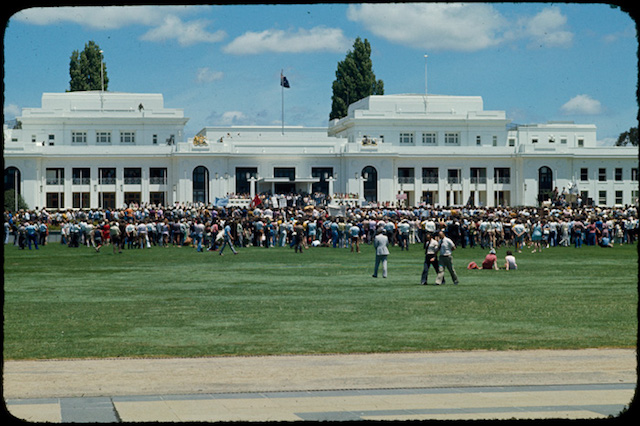This year saw the 40th anniversary of the dismissal of the Whitlam government on 11 November 1975 by the governor-general, Sir John Kerr. It also marks the 40th anniversary of an enduring conspiracy theory—that Kerr’s controversial action was instigated by US and UK intelligence agencies, especially the Central Intelligence Agency, with the Defence Department head, Sir Arthur Tange, as the link between Langley and Yarralumla.
By a mixture of design and coincidence, the year has also seen the publication of several books that bear, to varying degrees, on this theory. So how does the theory look now?
Two longstanding proponents of the theory, Guy Rundle and Brian Toohey, have used the anniversary to restate their views. They note, correctly, that the political-constitutional crisis of October-November 1975 coincided with a crisis in the Australia-US intelligence relationship, with elements of the CIA fearing that the Labor government wouldn’t renew the agreement on the ‘joint facility’ at Pine Gap. Tange was hugely agitated over the government’s handling of this issue. After adding other circumstantial evidence, including supposed links between Kerr and US intelligence agencies, observers like Toohey and Rundle joined the dots.
In November, Paul Kelly and Troy Bramston published The Dismissal: In the Queen’s Name to coincide with the 40th anniversary. It’s Kelly’s third book on the subject—each one, as he likes to quip, definitive—and it does include a good deal of new evidence, especially on the reactions of the Queen’s advisers to Kerr’s actions. The Dismissal was clearly composed and published at remarkable speed, with the inevitable side-effects of repetition and ill-chosen words. (For example, the authors describe a Palace official’s opinion of Kerr as ‘contemptible’, when they clearly mean ‘contemptuous’, reversing the meaning.) In journalistic style, they put the new material at the front of the book, which will only be meaningful to those who are generally familiar with the story.
Nevertheless The Dismissal is a fascinating and important account, blending the new material with the previous evidence. It’s as definitive as we are ever likely to see, unless Kelly writes a fourth version, with the narrative flow of his other political histories. Kelly and Bramston are ruthlessly critical of all three principals—Malcolm Fraser, Gough Whitlam and Kerr. Each man still has his defenders, but few arguments withstand the force of the book’s critical analysis.
One of the 19 chapters is devoted to demolishing what Kelly and Bramston call ‘The CIA Myth’. They reiterate the view, held by Kelly since 1976, that the security crisis and the constitutional crisis were parallel but unconnected. In the last 40 years, despite great efforts by Toohey, John Pilger and others, no-one has ever uncovered any hard evidence that the CIA or Arthur Tange was improperly implicated in the dismissal.
On the contrary, research has provided further indications that the smoking gun is never likely to be found. In my 2006 biography of Tange, I analysed the evidence concerning Tange’s role, or non-role, in the two crises, as well as the third crisis of spring 1975, the Indonesian intervention in East Timor. I argued that Tange’s actions and principles, as well as all available evidence, ran counter to the conspiracy thesis.
That contention was confirmed this year by James Curran’s Unholy Fury, a detailed, archive-based analysis of the crisis in Australia-US relations in the Whitlam-Nixon years. As Curran shows, Nixon ordered a fundamental re-examination of the ANZUS relationship, including the joint facilities: but by 1975, Nixon had been brought down by Watergate and his successor, Gerald Ford, was working to patch up the relationship. Nothing in Curran’s extensive research pointed towards CIA involvement in the dismissal.
Another 2015 publication, Jeremy Hearder’s biography of Sir James Plimsoll, brought another perspective to bear. Plimsoll was ambassador in Washington in the Whitlam years. Curran and Hearder give similar, but slightly divergent, accounts of Whitlam’s use, or failure to use, Plimsoll’s skills during the crisis in Australia-US relations.
Furthermore, Plimsoll and Kerr were both members of the Army’s wartime Directorate of Research and Civil Affairs. Rundle and others make much of Kerr’s involvement in DORCA, which they claim led to his close links with US intelligence agencies. In fact, DORCA wasn’t an intelligence organisation. As Graeme Sligo’s The Backroom Boys has shown, Plimsoll and Kerr were both involved in DORCA’s involvement in the area of military government.
When John Blaxland’s second volume of the official history of ASIO, The Protest Years, appeared, The Dismissal was already in press, but it too confirmed that ASIO records provided no evidence to support the CIA-Tange-dismissal theory. Moreover Blaxland’s account of ASIO’s activities in the 1960s and early 1970s showed that the bureaucratic politics of the period pointed in the opposite direction. As Secretary of External Affairs in the 1960s and of Defence in the 1970s, Tange had major confrontations with ASIO. He also had deep reservations about the CIA’s actions against foreign governments, which as he told the Americans undermined popular support for the alliance.
So we can end 2015 with even more confidence that the dismissal of the Whitlam government was instigated by Kerr himself, with no involvement by the CIA, other intelligence agencies, or Arthur Tange.
Finally, here’s a suggestion for those readers of The Strategist preparing courses for potential managers of our strategic, diplomatic, military or political affairs: prescribe a case study on Australia’s handling of the alliance crisis of the early 1970s, with a reading list based on the books mentioned here. The students would learn much about how to handle, or not to handle, a diplomatic crisis; and they would also learn a lot about what really matters, to both Australia and the US, in our most important alliance relationship.


